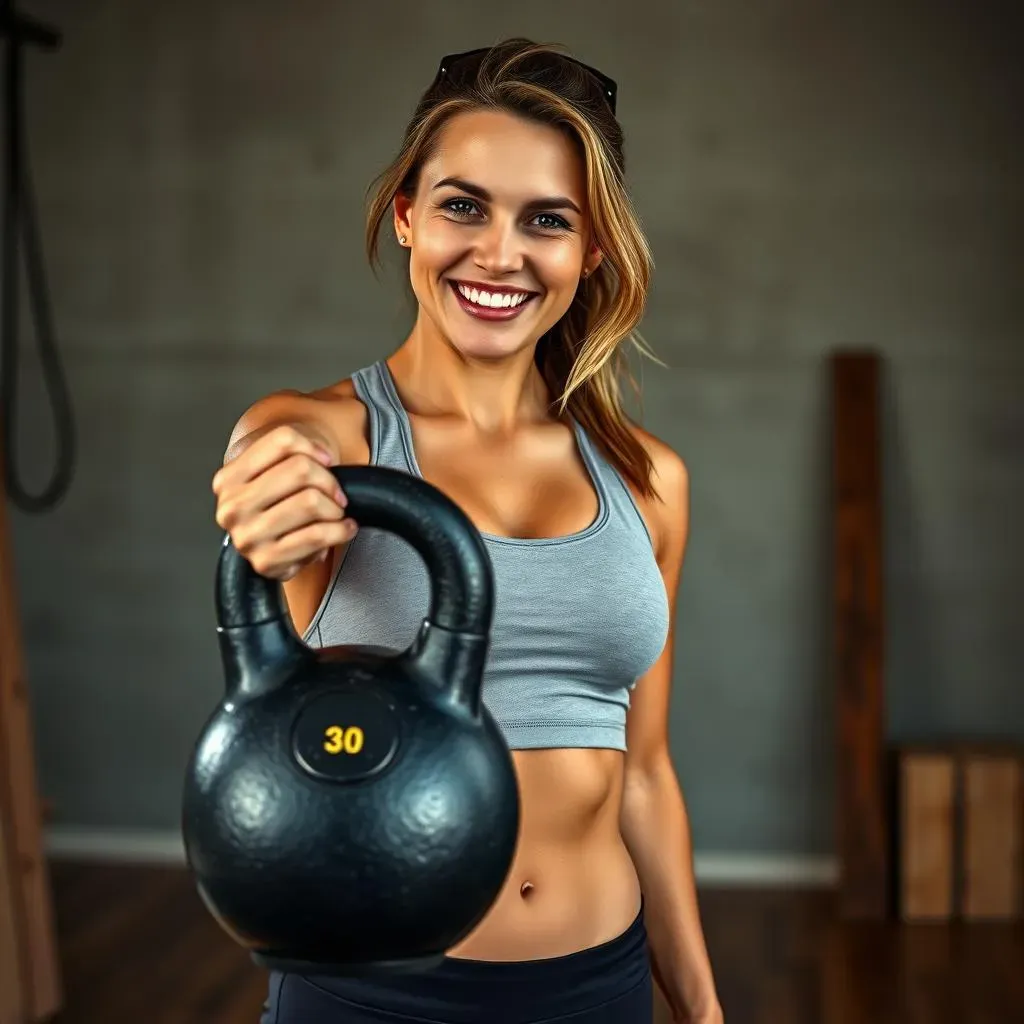Table of Contents
Ready to sculpt those arms? This guide is your passport to a fantastic "kettlebell arm workout beginner" experience. We'll be exploring simple yet effective exercises perfect for beginners, building a personalized workout routine, and mastering proper techniques to ensure you build strength safely and efficiently. Forget those bulky gym machines; kettlebells offer a unique blend of strength training and cardio, all in one compact package. Inside, you'll discover a curated selection of beginner-friendly exercises, learn how to structure your workouts for optimal results, and understand the importance of correct form to prevent injuries. Whether you're aiming for toned arms, increased strength, or simply a fun and effective workout, this guide will equip you with everything you need to succeed. Let's get started on your journey to stronger, more sculpted arms!
Beginner Kettlebell Arm Workout: Exercises to Tone and Strengthen

Beginner Kettlebell Arm Workout: Exercises to Tone and Strengthen
Bicep Blasters: Kettlebell Curls
Let's start with some bicep-building action! Kettlebell curls are fantastic for targeting those front-of-the-arm muscles. Grab a lightweight kettlebell—you want something you can control easily. Stand with your feet shoulder-width apart, knees slightly bent. Hold the kettlebell in one hand, palm facing forward. Keeping your elbow close to your side, curl the weight up towards your shoulder, squeezing your bicep at the top. Slowly lower the weight back down, controlling the movement. Repeat for 10-12 reps, then switch arms. Remember, proper form is key here; don't use momentum to swing the weight up – focus on that bicep burn! For a more intense workout, try alternating arms with each rep, or check out this beginner kettlebell workout for more ideas.
Don't worry if you feel a little shaky at first; it's totally normal. Start with a lighter weight and focus on perfecting your form before gradually increasing the weight. Think of it like this: you’re teaching your muscles a new dance move. It takes practice to get it right. Consistency is far more important than lifting heavy weight immediately. This is a marathon, not a sprint! A good rule of thumb is that if you can't complete all the reps with good form, you need a lighter kettlebell. And hey, even if you don't see immediate results, trust me, your muscles will thank you!
Exercise | Reps | Sets |
|---|---|---|
Kettlebell Curl (each arm) | 10-12 | 3 |
Tricep Triumphs: Overhead Press
Now, let's move on to the back of your arms – those triceps! The overhead press is a fantastic compound exercise that works your shoulders and triceps simultaneously. Start by standing with your feet shoulder-width apart, holding a kettlebell in both hands, close to your chest. Keeping your core engaged (imagine bracing for a punch!), slowly press the kettlebell straight overhead, extending your arms fully. Lower the weight back down slowly and with control. Again, aim for 10-12 reps and 3 sets. If you're feeling ambitious, try a variation with a single kettlebell. This will increase the challenge and help to build even more strength and balance. Find more inspiration in this kettlebell workout for female beginners.
Remember to breathe! Inhale as you lower the weight and exhale as you press it upwards. This helps to control the movement and makes the exercise more effective. And don’t be afraid to take breaks between sets. Listen to your body; it’s telling you what it needs. Rest is just as important as the workout itself. It’s during these rest periods that your muscles recover and rebuild themselves, becoming stronger and more resilient. So don’t skip them!
- Keep your core tight throughout the exercise.
- Control the weight throughout the movement.
- Focus on proper form over speed.
Building a Kettlebell Arm Workout Routine for Beginners

Building a Kettlebell Arm Workout Routine for Beginners
Crafting Your Perfect Workout Plan
So, you've mastered a few kettlebell arm exercises. Awesome! Now let's build a workout routine that's tailored to *you*. Think of it like building with LEGOs – you have a bunch of cool pieces (exercises), and now you need to assemble them into something amazing. We'll start with a simple, three-day-a-week plan, perfect for beginners. Each workout will focus on different muscle groups to ensure balanced development and prevent overtraining. Remember, consistency is key! It's better to do shorter, more frequent workouts with perfect form than long, infrequent sessions with sloppy technique. This is where a well-structured plan really shines; it keeps you focused and motivated. Check out this beginner kettlebell workout for some inspiration, and remember to always listen to your body.
A good starting point is to choose two bicep exercises and two tricep exercises from the previous section. You’ll also want to add in some full-body exercises to work your core, legs, and back. This helps to create a balanced workout and prevent muscle imbalances. A simple plan might look like this: Day 1: Biceps and Core; Day 2: Triceps and Legs; Day 3: Full Body. Remember, this is just a template; adjust it based on your fitness level and goals. Need more ideas? Take a look at this kettlebell workout for women.
Day | Focus | Exercises (Examples) |
|---|---|---|
1 | Biceps & Core | Kettlebell Curls, Plank, Russian Twists |
2 | Triceps & Legs | Overhead Press, Squats, Lunges |
3 | Full Body | Swings, Goblet Squats, Rows |
Progressive Overload: The Key to Growth
Once you feel comfortable with your initial routine, it's time to introduce "progressive overload." This simply means gradually increasing the difficulty of your workouts over time. This could involve increasing the weight of your kettlebell, adding more reps, or increasing the number of sets. You could even try adding more challenging variations of the exercises. The goal is to continually challenge your muscles, forcing them to adapt and grow stronger. Think of it as a game of “keep-away” with your muscles; the more you challenge them, the stronger they become to handle the challenge. Don't jump into heavy weights too quickly, though – focus on maintaining good form throughout. Small, consistent increases in difficulty are far more effective than sudden, drastic changes.
Remember, listen to your body. If you're feeling excessively sore or experiencing pain, take a rest day or two. Rest and recovery are crucial for muscle growth. Don't push yourself too hard, too fast. This is a journey, not a race. Consistency and gradual progression are far more important than trying to do too much too soon. Remember that feeling of accomplishment after a great workout? That's the feeling you want to build on. And if you need some additional motivation, consider trying this ultimate beginner kettlebell routine.
- Increase weight by 1-2 kg every 2-3 weeks.
- Add 2-3 reps per exercise every 1-2 weeks.
- Add an extra set every 2-3 weeks.
Tracking Your Progress: Celebrate Your Wins!
Keeping track of your progress is essential for staying motivated and seeing how far you've come. Start a simple workout journal to note down the exercises you do, the weight you use, the number of reps and sets, and how you felt during and after the workout. This will help you identify areas where you're excelling and areas where you might need to adjust your approach. It's also a great way to celebrate your wins, no matter how small they seem. Seeing your progress in black and white can be incredibly motivating. Remember that feeling of accomplishment after a tough workout? That’s the feeling you want to build on. You'll be amazed at how much stronger you get over time.
Don't be afraid to experiment with different routines and exercises. Find what works best for you and your body. There’s no one-size-fits-all approach to fitness. What works wonders for one person might not be ideal for another. And that’s perfectly okay. Remember, consistency is key. Even if you miss a day or two, don’t beat yourself up about it. Just get back on track as soon as you can. A little bit of consistency goes a long way. Consider trying a beginners kettlebell workout if you are unsure where to start.
"The only way to do great work is to love what you do.” – Steve Jobs
Safe and Effective Kettlebell Arm Workout Techniques for Beginners

Safe and Effective Kettlebell Arm Workout Techniques for Beginners
Safe and Effective Kettlebell Arm Workout Techniques for Beginners
So, you're ready to dive into kettlebell arm workouts, but safety's your top priority – smart move! Let's talk technique. First, choose the right kettlebell weight. Too heavy, and you risk injury and poor form; too light, and you won't see results. Start light, focusing on perfect form before gradually increasing the weight. Think of your body as a finely tuned machine; you wouldn't overload a delicate engine, would you? Remember, slow and controlled movements are key. Avoid jerky motions or using momentum to lift the weight. This is where those perfectly sculpted arms are built.
Engage your core muscles throughout each exercise. Imagine you're bracing for a punch – this will stabilize your body and protect your back. Maintain a neutral spine, avoiding rounding your back, especially during exercises like rows. This is crucial for preventing injury and maximizing results. Need a refresher on kettlebell basics? Check out this beginner kettlebell workout to get you started. Remember, consistency is key. It’s better to perform fewer reps with perfect form than many reps with poor form.
Technique Tip | Description |
|---|---|
Controlled Movements | Avoid jerky motions; focus on slow, deliberate movements. |
Core Engagement | Brace your core as if preparing for a punch. |
Neutral Spine | Maintain a natural curve in your back; avoid rounding. |
Warm-up before each workout. This prepares your muscles and joints for the work ahead, reducing your risk of injury. A simple warm-up could include arm circles, shoulder rotations, and light cardio like jumping jacks. Think of this like prepping your car engine before a long drive. Your body will thank you. Cool down after each workout, too. Gentle stretches will help your muscles recover and reduce soreness. Cool-downs are as important as the warm-up. Don’t skip this step. It makes a huge difference. For a more comprehensive guide, check out this kettlebell workout for women.
Listen to your body. Pain is a warning sign; don't ignore it. If you feel any sharp or persistent pain, stop the exercise immediately and consult a doctor or physical therapist. This isn’t a competition; it’s about building a stronger, healthier you. Remember, consistency trumps intensity. Small, consistent improvements over time are far more effective than sporadic bursts of intense activity. Need a structured plan? Try this beginner kettlebell workout.
- Warm-up before each workout (5-10 minutes).
- Cool down after each workout (5-10 minutes).
- Listen to your body and rest when needed.